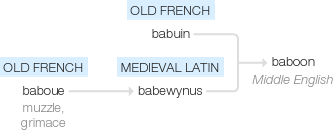Baboon
Middle English (denoting a grotesque figure used in architecture): from Old French babuin or medieval Latin babewynus, perhaps from Old French baboue ‘muzzle, grimace’.
wiktionary
From Middle English babewin, baboin, from Old French babouin, from baboue(“grimace; muzzle”), of Proto-Germanic origin, related to dialectal German Bäppe(“lips; muzzle”), Middle High German beffen(“to bark”), Middle English baffen(“to bark”). See also baff, baffle.
etymonline
baboon (n.)
type of old world ape, c. 1400, babewyn, earlier "a grotesque figure used in architecture or decoration" (early 14c.), from French babouin "baboon," from Old French baboin "ape," earlier "simpleton, dimwit, fool" (13c.), also "gaping figure (such as a gargoyle)," so perhaps from Old French baboue "grimacing;" or perhaps it is imitative of the ape's babbling speech-like cries. Also see -oon.
German Pavian "baboon" is from Dutch baviaan, from Middle Dutch baubijn, a borrowing of the Old French word. Century Dictionary says Arabic maimun probably is from the European words.
